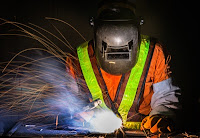For more information call Hotfoil-EHS at 609.588.0900 or visit http://www.hotfoilehs.com.
A blog that provides educational information on electric heating systems used on hoppers, chutes, tanks and vessels; electric heating systems used for pre and post weld heat treating; heat treating power consoles; custom heat treating furnaces; and single & multi-operator welders. For more information, visit HotfoilEHS.com
Showing posts with label welding. Show all posts
Showing posts with label welding. Show all posts
The Hotfoil-EHS Fusion 45 Induction Heating Console
Induction heating can improve your bottom line by decreasing weld failures, and decreasing setup and tear down times. The technology allows for accurate temp control, without heavy electrical service or complicated controls. The portability and ease of use will allow you to heat more welds faster.
For more information call Hotfoil-EHS at 609.588.0900 or visit http://www.hotfoilehs.com.
For more information call Hotfoil-EHS at 609.588.0900 or visit http://www.hotfoilehs.com.
Induction Heating Provides Welders Uniformity and Shortens Welding Time
Ovens are great for uniformity and control, but require transport and time. They're certainly not convenient.
A great alternative, one that provides excellent uniformity, control, and convenience, is induction heating.
Induction heating is unique because it uses molecular excitation as its source of heat, as opposed to open flames or external electric elements.
Induction heating works very quickly, and since there is no contact with the target piece, there are far less concerns about part contamination. Many industrial processes use induction heating when very high temperatures and uniform control is desired.
Its important to note that the heat is created from inside the object itself, with no open flame or external electric heat source.
Induction heating is used to heat conductive materials. Developed in the early 20th century, it quickly became a popular choice for hardening military equipment parts during wartime. Because of induction heating’s controllability, speed and consistent output, its popularity continued to grow as new manufacturing and production methodologies were developed. Today, induction heating has become a popular technology for the welding industry to provide pre and post-weld stress relief.
Induction heaters provide temperatures and cycle times hard to achieve otherwise. By virtue of their high temperature capabilities, very fast heat up times, precise application of heat, excellent controllability, and ease of setup / breakdown, the use of induction heating has been know to cut 30% to 50% of total weld cycle time in real-life welding applications.
Induction heaters consist of a few primary components: An electromagnet and an electronic oscillator that passes a high-frequency alternating current (AC) through the electromagnet. RF (radio frequency) energy is transferred into the workpiece via electromagnetic waves. These alternating magnetic waves penetrate the object, creating electric eddy currents. These eddy currents (Foucault currents) flow through the target piece and produce heat.
Pre and post-weld heat treating (stress relieving) is a growing market for induction heating systems because it offers significant benefits such as excellent heat placement and distribution, lower cycle times, safety, ease of use, and efficiency.
For more information about induction heaters for pre and post-weld heat treating visit HotfoilEHS at http://www.hotfoilehs.com or call 609.588.0900.
All Stainless Heat Treat Power Consoles
 |
| Hotfoil-EHS Stainless Steel Power Consoles |
With decades of experience in challenging applications, and thousands of successful installations, Hotfoil-EHS maintains their well deserved reputation as the highest quality and most competitively priced manufacturer of heat treat power consoles in the world.
Fusion45: New Rugged Induction Heater Improves Weld Quality
 |
| New Welding Induction Heater |
Induction heating works very quickly, and since there is no contact with the target piece, there are far less concerns about part contamination. Many industrial processes use induction heating when very high temperatures and uniform control is desired.
Pre and post-weld heat treating (stress relieving) is a growing market for induction heating systems because it offers significant benefits such as excellent heat placement and distribution, lower cycle times, safety, ease of use, and efficiency.
Induction heating can improve your bottom line by decreasing weld failures, and decreasing setup and tear down times. The technology allows for accurate temp control, without heavy electrical service or complicated controls. The portability and ease of use will allow you to heat more welds faster.
Check out the new Hotfoil-EHS Fusion45 Induction Heater:
Diagram of Equipment for Typical Weld Heat Treating
 |
| Weld preheat console in use |
The heating may or may not continue during welding, dependent on the heat generated by the arc. The goal is to maintain a certain temperature from the first weld pass to the last.
Preheating produce several very beneficial effects, including producing a more ductile metallurgical structure that cracks less, helps in releasing trapped hydrogen, and reduces stress cracking during cooling.
It is always recommended that you should consult with weld heating experts and learn the fundamentals of this process in order to avoid costly errors in preparation or wasting money on the using the wrong equipment.
Here is a very general diagram of the typical welding pre-heat equipment layout.
For more information, visit HotfoilEHS.com or call 609.588.0900
Pre and Post-weld Stress Relief with Induction Heating
Induction heating is unique because it uses molecular excitation as its source of heat, as opposed to open flames or external electric elements. Conduction heaters consist of a few primary components: An electromagnet and an electronic oscillator that passes a high-frequency alternating current (AC) through the electromagnet. RF (radio frequency) energy is transferred into the workpiece via electromagnetic waves. These alternating magnetic waves penetrate the object, creating electric eddy currents. These eddy currents (Foucault currents) flow through the target piece and produce heat. Its important to note that the heat is created from inside the object itself, with no open flame or external electric heat source.
Induction heating works very quickly, and since there is no contact with the target piece, there are far less concerns about part contamination. Many industrial processes use induction heating when very high temperatures and uniform control is desired.
Pre and post-weld heat treating (stress relieving) is a growing market for induction heating systems because it offers significant benefits such as excellent heat placement and distribution, lower cycle times, safety, ease of use, and efficiency.
Induction heaters provide temperatures and cycle times hard to achieve otherwise. By virtue of their high temperature capabilities, very fast heat up times, precise application of heat, excellent controllability, and ease of setup / breakdown, the use of induction heating has been know to cut 30% to 50% of total weld cycle time in real-life welding applications.
For more information about induction heaters for pre and post-weld heat treating contact:
Hotfoil-EHS, Inc.
2960 East State Street Ext.
Hamilton, NJ 08619
Phone # 609.588.0900
Fax # 609.588.8333
www.hotfoilehs.com
Demand Pulse Welding: A Brief History
 |
| Demand Pulse Welder |
From the 1930’s until 1990, nearly all Multiple Operator Systems were the same general layout – a big bulk power supply, with “grids” connected by means of cable to form a system of distributed power. Originally designed for use in shipyards, this system minimized the use of high voltage primary power, distributing 75-80 volts of secondary voltage instead.
Historically, the most common application of resistor controls has been in Multiple Operator Welding Systems, widely used in shipyards and heavy construction. Nearly all the Nuclear Electric Power Plants were built using Multiple Operator Systems.
Big Four Manufacturing Company of Saint Louis, Missouri, pioneered the concept of connecting Multiple Operator systems in a complete loop configuration. This LOOP concept greatly improved the voltage stability of Multiple Operator systems, because with all the power connected to a single circuit, voltage drops were reduced or eliminated due to the nature of a DC circuit. In 1977, Big 4 Manufacturing introduced their innovative and very successful Series 77 Control.
After the Three Mile Island incident and the subsequent slowing of the Nuclear Power Industry, Big 4 decided it was in their best interest to expand into the general fabricating, refinery and petro-chemical markets. Their popular soft arc was great for most welding, but was inadequate on pipe root passes with 5P, then the most common method use for oil related pipe. To provide an arc better suited for pipeline, Big 4 devised a circuit to make their resistor grid “think” it was a Lincoln generator. They called this new system “Arc Ram”. Arc Ram worked beautifully with 5P and similar electrodes and led to the design of a MIG system which they called Demand Pulse.
Not to be confused with ...
"Short-circuiting Metal Transfer" (Short Arc) welding was introduced by Linde in the late fifties for welding sheet metal. During the 1960s, short-arc became widely used, sometimes for the wrong applications. When using short-arc the wire can contact the molten weld pool resulting many times with the weld not fusing to the base metal. This is called a "cold lap". Cold lap associated with Short Arc became a reason why many welding shops won’t use “wire” welding processes on pressure welds. Unfortunately, mis-used Short Arc welding gave ALL GMAW welding on pressure welds a bad name.
Demand Pulse to the Rescue
Demand Pulse rarely extinguishes the arc. Metal transfers through the arc, and the arc’s are much shorter than those from Pulse Spray. The transfer occurs above the molten pool, so spatter doesn't explode from the puddle. It is a "constant current" process. The operator selects a base current, similar to some GMAW Pulse Spray applications, adjusts the wire feed speed to give the correct voltage, and begins to weld. Lower voltage will cause the puddle to freeze faster, higher voltage will cause the puddle to be more fluid.
In short arc, a current pulse is triggered by the short-circuit condition caused by the wire driving into the work piece. Demand Pulse forces the transfer to occur before short-circuit, at a voltage selected by the operator, above the weld pool. This has two important effects: the arc does not extinguish and the spatter level is greatly reduced because the molten tip of the wire does not contact the weld pool. Because the arc is not extinguished, cold laps are virtually eliminated.
Many reference books describe short arc as a "random pulse" method of welding. Random in the sense that the pulse is triggered as a function of wire feed speed. The faster the wire feed speed, the faster the short circuits (pulses). Demand Pulse is exactly the same, except it does not short!
This blog post was abstracted from a 2004 press release from Aftek Welders, the only remaining company providing resistor controlled welding machines, and parts supplier for all Multiple Operating Systems. You can read the full version of "AFTEK – the Best Welders you never heard of…” here.
New Video Highlighting Custom Heat Treating Power Console Examples
This new video illustrates the variations in design and custom capabilities Hotfoil-EHS has for building specialized power consoles. Special power requirements, corrosion-resistance, weather-proofing, custom paint or coatings, special control options and custom cable sets are all available from Hotfoil-EHS. Challenge them with your toughest heat treating requirement. You'll be pleasantly surprised with the response.
Hotfoil EHS Provides "The Heat" for Strong, New Tappan Zee Bridge
Hotfoil EHS is working closely with the bridge contractors supplying welding heat treating equipment. Large metal structures, such as bridge supports, pilings, and girders need careful pre-heating and post heating to ensure strong, lasting welds. Contractors on the Tappan Zee Bridge specified Hotfoil EHS power consoles, electric heaters, and thermocouples for their welding heat treating requirements.
 |
| Clam shell heater. |
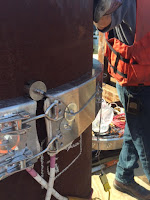 |
| Close-up of heater fastener. |
For more information, visit http://www.hotfoilehs.com.
 |
| Piling with clam shell heater and thermocouples installed. |
 |
| 6 Way Power Console |
New Video on Ceramic Mat Heaters for Welding Heat Treating
Just a short video on Hotfoil EHS pre and post weld heat treating mat heaters (also known as pad heaters).
New Hotfoil EHS Welcome Video
We just introduced a new Hotfoil EHS Welcome video for our YouTube Channel. Check it out!
Ceramic Pre Weld and Post Weld Heaters Get The Heat to the Weldment Efficiently
 |
| Ceramic mat heaters |
Design:
1) Sintered alumina oxide is formed into shapes and fired at precise temperatures to produce a ceramic insulator with a combination of high dielectric strength and efficient, fast heat transfer. This ceramic is also solid enough to withstand physical shock and resistance to oxidation and corrosion from a broad range of chemicals and atmospheres.
2) An accurately measured length of stranded nickel-chromium wire is precisely wound through the ceramic beads ensuring electrical isolation to produce a compact and flexible resistance heater. Suitable for operation at 2000 deg. F.
3) The resistance wire is then metallurgically bonded to a stranded nickel-copper wire to provide trouble free electrical continuity. The flexible stranded cold junction wire is connected to brass Twistlock connectors fitted with insulated sleeves. The cold junction extension leads are rated for 250 deg. C continuous temperature.
Ceramic mat heaters are efficient, time-tested, and proven heater technology in pre-weld and post weld heating, and are designed for the harsh realities of the welding environment.
For more information, contact:
Hotfoil-EHS, Inc.
2960 East State Street Ext.
Hamilton, NJ 08619
Phone # 609.588.0900
Fax # 609.588.8333
www.hotfoilehs.com
Portable Hardness Testing for Field Welding
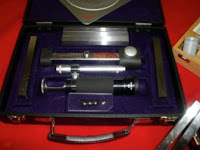 |
| Portable Hardness Testing Kit |
Various methods and procedures are used to measure hardness. One method is to create a "dent" on a target material (under controlled conditions) and then carefully measure the resulting indentation. The indentation correlates directly to the hardness of the material. In very general terms, the smaller the mark, the harder the material, and the larger the indentation, the softer the material.
The Brinell Hardness Number (BHN) and Brinell testers are very popular. Brinell testing is done by pressing a perfectly spherical ball (10 mm in size) into a target material with a force of over 6600 lbs (3000kg to be exact) for a minimum of 10 seconds, and then measuring the resulting impression. After which, the size of the impression is measured by an optically scaled microscope positioned over the impression.
Laboratory Brinell testers are obviously impractical in the field, but portable, lightweight Brinell testers are available for weld hardness testing in the field. These portable testers are easily transported and simple to use. No special training is required and in a few minutes anyone can learn to determine a Brinell Hardness Number accurately.
The accuracy of portable Brinell testers are done via NIST traceable test bars. The test bars are calibrated to a uniform hardness of ±3% of their labeled Brinell Hardness Number. Additionally, the microscopes used for measurement are capable of reading within .05 millimeters.
Typical Field Procedure
A test bar with a known BHN, and approximately the hardness of the target material to be tested, is chosen. The test bar is inserted into the Brinell test instrument and the instrument placed upon the specimen. A steel impression ball, secured in the the head of the instrument, is in contact with both the test bar and the target material. Built-in to the test instrument is an anvil, which is then struck sharply with a hammer. Via the impression ball, the impact of the hammer, regardless of force, is transmitted equally to the test bar and to the target material, leaving marks in both. The diameters of the resulting indentations are directly related to the respective hardnesses of the test bar and the specimen. The bar is removed from the test instrument and the microscope is positioned over the appropriate indentation. The impression in the specimen metal is measured in the same manner and the hardness is determined.
For more information on portable Brinell Harness Test kits, contact:
Hotfoil-EHS, Inc.
2960 East State Street Ext.
Hamilton, NJ 08619
Phone # 609.588.0900
Fax # 609.588.8333
www.hotfoilehs.com
Postweld Heat Treatment
 |
| Some welding operations require postweld heat treatment |
There are numerous welding methods, as well as specific procedures that are applicable to different metal alloys and intended use of the finished product. Some of these procedures involve controlled heating and/or cooling of the weld and the closely adjacent area of the parts being joined. This is generally termed heat treatment, and more specifically, preheating and postweld heat treatment.
Heat treatment, in any form, is a time consuming and costly operation. Strength, toughness, corrosion resistance, and residual stress of the joint are all impacted by the proper application of heat treatment. Many application codes and standards require specific protocols for heat treating, which is utilized to achieve a specific resulting condition in the subject material or to restore material characteristics altered by production processes such as welding.
Stress relief is a benefit and goal of postweld heat treatment. During the welding process, base materials near the weldment, deposited weld metal, and the heat affected zones exhibit different levels of metallurgical phase transformation. Various degrees of material hardening occurs, particularly in the heat affected zone adjacent to the weld metal deposit, with high stresses due to melting and solidification. Stress relief through heat treatment is accomplished by controlled heating and cooling of the affected material area to relieve a significant amount of the imposed stresses. This postweld heat treatment can reduce the hardness and increase ductility, lessening the incidence of cracking in weldments. The process generally involves maintaining the target area at a specific temperature (soaking), then executing a controlled cooling schedule.
One respected source, TWI, sums up post weld heat treatment (PWHT).....
The necessity for PWHT depends on the material and the service requirements. Other factors that influence the need for PWHT are the welding parameters and the likely mechanism of failure. In some standards, PWHT is mandatory for certain grades or thicknesses, but where there is an option, cost and potential adverse effects need to be balanced against possible benefits. The energy costs are generally significant due to the high temperatures and long times involved, but costs associated with time delays may be more important. Detrimental effects include distortion, temper embrittlement, over-softening and reheat cracking, which means that control of heating and cooling rates, holding temperature tolerances and the times at temperature are extremely important, and must be carefully controlled in order to realise the full benefit of the process.
The precise level of heat control, as well as the substantial quantity of heat, required to successfully accomplish a PWHT protocol calls for the use of special purpose equipment intended for PWHT. Hotfoil EHS is a recognized manufacturer of industrial application heating equipment and specializes in the design and manufacture of power consoles, ceramic mat heaters, and accessories for pre and post-weld heat treatment. Share your application challenges with them and work together to develop a cost effective solution.
Rely on Experienced Welding and Heating Applications Experts for Improved Outcome and Efficiency
 |
| Work with the manufacturer's experts for better outcomes |
Manufacturers provide services that may help you save time and cost, while also achieving a better outcome for the entire project. Consider a few elements the technical sale rep brings to your project:
- Product Knowledge: Product managers and sales support personnel will be current on product offerings, proper application, and capabilities. They also have information regarding what products may be obsolete in the near future. This is an information source at a level not generally accessible to the public via the Internet.
- Experience: As a project engineer, you may be treading on fresh ground regarding some aspects of your current assignment. There can be real benefit in connecting to a source with past exposure to your current issue.
- Access: Through the manufacturer's internal applications people, you may be able to establish a connection to “behind the scenes” information not publicly available. The people at the manufacturer can provide answers to your application questions.
Develop a professional, mutually beneficial relationship with the manufacturer's technical sales team, and don't be shy to develop a professional and trusting relationship. Their success is tied to your success and they are eager to help you.
Pre Weld and Postweld (PWHT) Heat Treatment Furnaces
Industrial furnaces are used for pre and post-weld heat treating by welders and fabricators to heat-treat weldments or metallic parts. Industries that require these types of furnaces include pressure vessels and piping, storage tanks, building construction, bridge building, offshore platforms, petrochemical plants, power plants, and oil and gas refineries.
By using furnaces for PWHT, stress introduced by the welding process is reduced and redistributed through the heating, soaking and cooling the weldment/machined surface. This greatly improves the weld properties. PWHT is most times mandatory in order to comply with welding codes and specifications for the welding of carbon steels, stainless/high alloy steels and work hardened steels.
Fairly sophisticated control systems carefully follow mandatory heating and cooling profiles, as outlined by welding code. Control systems with thermocouples that monitor internal furnace temperature, along with weldment part temperature are usually included. These control systems also include the ability to ramp up to temperature and cool off over specified time intervals. Finally, the use of recorders or data loggers is common for quality control documentation.
 Additional benefits of pre and post weld heat treating are:
Additional benefits of pre and post weld heat treating are:
 Most pre or post weld heat treating furnaces are customized in one way or another, whether it size, total BTU output, energy source (electric, gas, oil), control scheme, door configuration, or having the furnace built on wheels or on rails.
Most pre or post weld heat treating furnaces are customized in one way or another, whether it size, total BTU output, energy source (electric, gas, oil), control scheme, door configuration, or having the furnace built on wheels or on rails.
 Furnaces can be designed permanently, portable, or field erected. By having the furnace local, or right on-site, companies eliminate the need to send parts out and thus save time and costs associated with shipping. Depending on the scope of work, its not uncommon for the investment made in a fabricated furnace to pay off within the first year.
Furnaces can be designed permanently, portable, or field erected. By having the furnace local, or right on-site, companies eliminate the need to send parts out and thus save time and costs associated with shipping. Depending on the scope of work, its not uncommon for the investment made in a fabricated furnace to pay off within the first year.
For more information on any custom built pre heat or post weld heat treat furnaces, contact:
Hotfoil-EHS, Inc.
2960 East State Street Ext.
Hamilton, NJ 08619
Phone # 609.588.0900
Fax # 609.588.8333
Email: dap@hotfoilehs.com
By using furnaces for PWHT, stress introduced by the welding process is reduced and redistributed through the heating, soaking and cooling the weldment/machined surface. This greatly improves the weld properties. PWHT is most times mandatory in order to comply with welding codes and specifications for the welding of carbon steels, stainless/high alloy steels and work hardened steels.
Fairly sophisticated control systems carefully follow mandatory heating and cooling profiles, as outlined by welding code. Control systems with thermocouples that monitor internal furnace temperature, along with weldment part temperature are usually included. These control systems also include the ability to ramp up to temperature and cool off over specified time intervals. Finally, the use of recorders or data loggers is common for quality control documentation.
 Additional benefits of pre and post weld heat treating are:
Additional benefits of pre and post weld heat treating are:- Improved ductility and/or harness
- Lower risk of brittle fracture
- Improved metallurgical structure
- Reduction in diffusible hydrogen induced cracking
 Most pre or post weld heat treating furnaces are customized in one way or another, whether it size, total BTU output, energy source (electric, gas, oil), control scheme, door configuration, or having the furnace built on wheels or on rails.
Most pre or post weld heat treating furnaces are customized in one way or another, whether it size, total BTU output, energy source (electric, gas, oil), control scheme, door configuration, or having the furnace built on wheels or on rails. Furnaces can be designed permanently, portable, or field erected. By having the furnace local, or right on-site, companies eliminate the need to send parts out and thus save time and costs associated with shipping. Depending on the scope of work, its not uncommon for the investment made in a fabricated furnace to pay off within the first year.
Furnaces can be designed permanently, portable, or field erected. By having the furnace local, or right on-site, companies eliminate the need to send parts out and thus save time and costs associated with shipping. Depending on the scope of work, its not uncommon for the investment made in a fabricated furnace to pay off within the first year.For more information on any custom built pre heat or post weld heat treat furnaces, contact:
2960 East State Street Ext.
Hamilton, NJ 08619
Phone # 609.588.0900
Fax # 609.588.8333
Email: dap@hotfoilehs.com
Multi-Operator Welding Systems
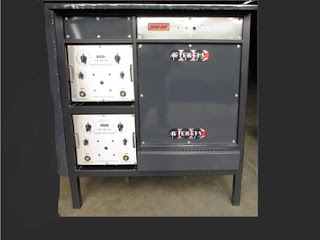 |
| Multi-operator welding system (Aftek Quad Arc 1200) |
Most arc welding operations are performed using direct current from a DC power source an AC power source which has been rectified from AC to DC. Many industries use these welding processes in a wide variety of environments including factories, construction sites, power plant construction, boiler construction and repair, and shipyards.
Multiple operator welding equipment was developed to allow several welding modules to operate from a single common power supply. The power supply typically includes a transformer and rectifier to step down the supply voltage, and then convert the power from AC to DC.
Multi-station welding systems afford a number of advantages the principals of which are a lower initial capital cost, a much lower cost of installation, much lower maintenance cost and less power requirements as compared with single operator equipment. Multi-operator welding systems are practical and efficient as they provide a welding station where each welder has the ability to work. They provide for multiple simultaneous welding projects where workers can work efficiently and meet production deadlines.
The clear advantages of multi-operator welders:
- Improved productivity
- Lower total cost of ownership
- Less equipment to transport
- Reduced maintenance costs
- Noise reduction
Portable Auxiliary Power Boxes (PAPB) for Convenient Source to Run Tools, Save Time, Improve Safety
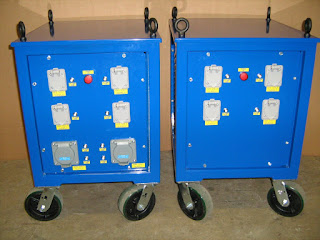 |
| Portable Auxiliary Power Boxes (PAPB) 30kVA (left) and 15kVA (right) |
In many field welding situations simply having convenient access to 120 volt or 240 volt supply power to run auxiliary power tools such as grinders, stud guns, and drills is important. In some situations, bringing power to these locations can difficult or nearly impossible. Worse yet, short-cuts and quick fixes can compromise safety. While its not uncommon to have an available 480 or 575 volt power source, conversion to 120 or 240 volts is a challenge. Simply running extension cords can be impractical or present a safety hazard. What's really needed is a portable power box, with all necessary transformers, circuit protection and safety devices built-in to conveniently convert high voltage to 120/240 volt power.
 |
| Internal view of cabling and outlets |
A new product by Hotfoil-EHS has been developed for just this situation. Named the PAPB (short for portable auxiliary power box), the new product taps into the available high voltage feed and puts convenient, usable 120/240 volt power right at the worker's location.
The PAPB is designed with small supplementary circuit breakers at each of the outgoing power connections for protection and ease of resetting. The main power supply is also protected by a main circuit breaker.
Portable auxiliary power box's can be custom made and manufactured in virtually any size. The ones pictured above are relatively small; 15kVA and 30kVA.
The PAPB is designed with small supplementary circuit breakers at each of the outgoing power connections for protection and ease of resetting. The main power supply is also protected by a main circuit breaker.
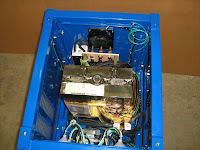 |
| Transformers made in-house |
Portable auxiliary power box's can be custom made and manufactured in virtually any size. The ones pictured above are relatively small; 15kVA and 30kVA.
 |
| Internal view |
All PAPB's are made in the USA with major components being fabricated in-house. All framework, tubing, sheet metal, transformers, wiring, and assembly is done at Hotfoil-EHS's production facility in Hamilton, NJ. The units are 100% QC'd and tested prior to shipping. When the equipment leaves the factory, it is 100% ready to go to work.
For more information, contact:
Hotfoil-EHS, Inc.
2960 East State Street Ext.
Hamilton, NJ 08619
Phone # 609.588.0900
Fax # 609.588.8333
Email: dap@hotfoilehs.com
The TAU: A Perfect Solution for Fast, Strong, and Inexpensive Thermocouple, Stud, and Pin Welidng
 |
| Thermocouple attachment unit (TAU) used for creating thermocouples quickly and inexpensively, plus welding studs and pins to metal structures. |
Thermocouple attachment units (TAUs) are small, self contained spot welders that achieve superior results for welding thermocouple junctions and attachment. They are portable and are easy to use. Also known as thermocouple welders, these units are provide a capacitive discharge (as the energy source) in a compact, self-contained, hand welding unit. They are designed to form very strong, free standing junctions in just seconds using standard thermocouple wire. There's no need for clamping, bracketing or strapping. TAUs provide a direct bonding method for thermocouples, pins and studs that is quick, easy, and low-cost while still providing accurate temperature measurement.
Thermocouple attachment units continue to enhance their power outputs which creates more potential uses for TAUs. Higher power output opens doors to a broader application base. Higher power TAUs can be used to weld thermocouple pairs but also can be used to weld studs, rods and pins to a wide variety of metal structures. For example, a common use for TAU’s is attaching insulation pins to welding insulation blanket support.
An internal power supply constantly recharges an internal battery giving the operator portability in field thermocouple welding. Readily available controls allow for easy adjustment based on wire size and material.
Thermocouple attachment units offer a very convenient and economical method of forming and attaching thermocouple sensing wires, studs, and pins where and when you need them. Models vary based on requirements. Some models accommodate a greater range of wire sizes and materials, handling wire up to 14 gauge and capable of creating weld junctions in under a second. Because the power supply provides a short recharge interval, multiple welds can be done very quickly (4-6 welds per minute).
For more information on thermocouple attachment units, contact:
Hotfoil-EHS
2960 East State Street Ext.
Hamilton, NJ 08619
Phone # 609.588.0900
Fax # 609.588.8333
Email: dap@hotfoilehs.com
www.hotfoilehs.com
Aftek at CastExpo 2016
The single largest trade show and exposition for metalcasting in
the Americas, CastExpo, is being held in the Minneapolis Convention Center April 16 through the 19th, 2016.
Held every three years, CastExpo offers metalcasters, suppliers, and casting buyers and designers the opportunity to connect and educate themselves on the latest metalcasting has to offer.
The Metalcasting Congress technical program and additional workshops cover a wide range of topics. Identify which specific technical presentations and workshops you would attend that is relevant to your company and its immediate and future challenges.
Held every three years, CastExpo offers metalcasters, suppliers, and casting buyers and designers the opportunity to connect and educate themselves on the latest metalcasting has to offer.
 |
| Aftek Quad Arc Welder |
Aftek (Division of Hotfoil-EHS) will be attending displaying their Quad Arc heavy duty arc welder, Quad Arc are:
designed for low maintenance in harsh environments. Features of the
designed for low maintenance in harsh environments. Features of the
- Submerged arc.
- Air arc gouging to ½” electrodes.
- FCAW (flux core MIG) all positions, self or gas shielded.
- Performing outstanding results on stainless, or steel castings.
- Power sources, rated for 100% duty cycle. Amperage range adjustable in 5 amp increments.
- Designed with Harsh Environment in mind.
- Designed with a single transformer on the MV1500G1.
- Powder Coated for a long lasting durable paint job.
- Protected with thermostatically controlled alarms on the rectifiers and the transformers.
- Designed to shut down if any of the Alarms are Energized.
- Easy-to-reset overload breaker for circuit protection.
- Optional protection for incoming Primary Power.
- Dimensions 51” Wide x 40” Deep x 57” Tall.
Subscribe to:
Posts (Atom)



